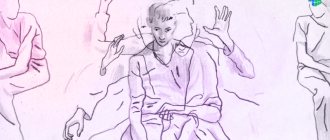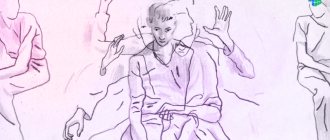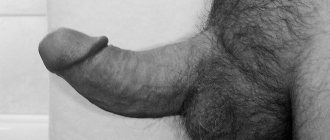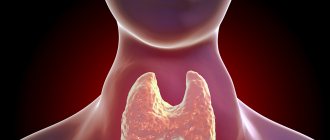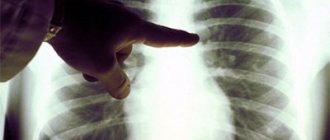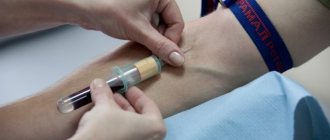Symptoms
The disease progresses slowly but steadily. Acute onset is extremely rare. In 30-40% there is a period of prodrome with the presence of asthenic, depressive syndrome, decreased appetite, and attention disorder. This period can last up to several months.
The onset of Creutzfeldt-Jakob disease is expressed in the development of intellectual and affective disorders. The patient also begins to experience headaches, dizziness, speech impairment, and visual impairment. A neurological examination can determine the presence of ataxia and changes in visual fields. Sometimes the patient has myoclonus.
As the disease progresses, central paresis of the limbs develops, pronounced extrapyramidal disorders develop, generalized convulsive seizures may develop, and dementia of the Alzheimer's type increases. Eventually coma develops and later death occurs.
Clinically, six main forms of Creutzfeldt-Jakob disease can be distinguished, depending on the severity of certain symptoms:
- Occipital (according to the author - Heidenhain): the posterior parts of the cortex are affected, blindness develops early.
- Ataxic (Brownell-Oppenheimer): the trunk, cerebellum is affected, the main symptom is ataxia.
- Extrapyramidal (Stern-Garcia): the basal ganglia are affected, and the phenomena of parkinsonism come to the fore.
- Frontal (Jacoba): the frontal lobe is affected, mental disorders prevail.
- Amyotrophic: rare, neurons of the anterior horns are affected (development of movement disorders).
- Panencephalopathic (Mizutani): diffuse damage to gray and white matter with a varied clinical picture, severe cerebral disorders.
Classification of Creutzfeldt-Jakob disease
According to the classification, Creutzfeldt-Jakob disease is divided into 4 types:
- Classical. In this form of the disease, prions attack the brain for no apparent reason. This type of mad cow disease is most often observed in people over 50 years of age, and is extremely rare - in 1-2 cases per million. The infection manifests itself as memory loss, sudden mood changes, and decreased interest in life. Subsequently, the patient loses the ability to care for himself, loses vision and practically stops speaking. In the final stages, the patient experiences severe hallucinations.
- Hereditary. The course of the stages of the disease is similar to the classical type, but the cause of the disease is the genetic inheritance of prions.
- Iatrogenic. The patient becomes infected with this type of disease during surgery through medications, poorly sterilized instruments, and membranes used to close wounds. In the 21st century, the likelihood of contracting Creutzfeldt-Jakob disease during surgery is almost zero.
- New option. A form of the disease in which infection occurs through meat foods containing infected tissue. More than a hundred cases of the disease have been reported since 1995. The disease especially often affects young people, with an average age of 20 years. The initial stage of the disease is marked by depression, loss of interest in hobbies and work, isolation and a desire for loneliness. Next comes a lack of coordination of movements, an inability to eat and clean up on one’s own. Unlike the classical type, with this variant of the disease dementia occurs last, and the patient is aware of everything that is happening to him.
Diagnostics
Diagnosis of Creutzfeldt-Jakob disease is based on data from the clinical picture, neurological status, and cases of consumption of animal meat from outbreaks of animal spongy encephalopathy.
It is also necessary to exclude other pathologies that could lead to clinical manifestations of the disease. Thus, an EEG study reveals background plane oscillations in the form of waves consisting of three phases. These waves can be superimposed by sharp and slow high-amplitude waves with a frequency of about 2 Hz.
MSCT and MRI studies reveal signs of brain tissue degeneration. Blood and cerebrospinal fluid, as a rule, do not change. A reliable diagnosis is considered after a lifetime brain biopsy using special molecular research methods. If it is impossible to conduct the study, or if the patient or his legal representatives disagree, the diagnosis is considered probable, but not confirmed.
Causes of Creutzfeldt-Jakob disease
The main cause of this disorder is considered to be eating meat from animals suffering from spongy encephalopathy. In addition, there have been cases of infection of patients in medical institutions through poorly sterilized surgical instruments or through transplanted tissue. Episodes of infection of people undergoing hormone therapy aimed at eliminating growth hormone deficiency, when treatment was carried out using tissue extracts containing this hormone, have been described.
In addition to cases of infection from the outside, there is a hereditary factor that causes Creutzfeldt-Jakob disease. This form of the disease is associated with a mutation in the PRNP gene. This disorder causes the appearance of pathological prions in the body. The hereditary disease is observed in 10-15% of families in which any form of this disorder has ever been diagnosed.
Creutzfeldt-Jakob disease
prion proteins are not similar in amino acid sequence to yeast prion proteins. Despite this, the main structural features (formation of amyloid fibers and high specificity that prevents the transfer of prions from one type of organism to another) are common to them. However, the prion responsible for mad cow disease has the ability to be transmitted from species to species. Studies of the brain tissue of animals that died from prion infections showed that prions do not contain nucleic acids, but are proteins. the first characterized prion proteins was PrP (from English prion-related protein or proteinase - resistant protein ) with a mass of about 35 kDa. It is known that PrP can exist in two conformations - “healthy” - PrPC, which it has in normal cells (C - from the English cellular - “cellular”), in which alpha helices predominate, and “pathological” - PrPSc, actually prion (Sc- from scrapie), which is characterized by the presence of a large number of beta strands. When entering a healthy cell, PrPSc catalyzes the transition of cellular PrPC to the prion conformation. The accumulation of prion protein is accompanied by its aggregation, the formation of highly ordered fibrils (amyloids), which ultimately leads to cell death. The released prion appears to be able to penetrate neighboring cells, also causing their death. The functions of the PrPC protein in a healthy cell have not yet been determined. Normally, the PrPC protein is associated with the cell membrane and is glycosylated with a sialic acid residue. It makes cyclic transitions into the cell and back to the surface during endo- and exocytosis. One such cycle lasts about an hour. In an endocytic vesicle or on the cell surface, the PrPC molecule can be cut into two approximately equal parts by proteases. The mechanism of spontaneous occurrence of prion infections is not completely clear. It is believed (but not yet fully proven) that prions are formed as a result of errors in protein biosynthesis. Mutations of genes encoding prion protein (PrP), translation errors, proteolysis processes are considered the main candidates for the mechanism of prion formation. According to recent research, prions are capable of Darwinian evolution through the action of natural selection. There is evidence to suggest that prions are not only infectious agents, but also have functions in normal bioprocesses. For example, there is a hypothesis that the mechanism of genetically determined stochastic aging occurs through prions. A person can become infected with prions contained in food, since they are not destroyed by enzymes in the digestive tract. Freely penetrating through the wall of the small intestine, they ultimately enter the central nervous system. This is how a new variant of Creutzfeldt-Jakob disease (nvCJD) is transmitted, which people become infected with after eating beef containing nerve tissue from cattle with bovine spongiform encephalopathy (BSE, mad cow disease). Prions can also enter the body parenterally. Cases of infection have been described through intramuscular administration of drugs made from human pituitary glands (mainly growth hormones for the treatment of dwarfism), as well as infection of the brain with instruments during neurosurgical operations, since prions are resistant to currently used thermal and chemical methods of sterilization. This form of Creutzfeldt-Jakob disease is designated iatrogenic (1CJD). Under certain, unknown conditions, spontaneous transformation of a prion protein into a prion can occur in the human body. This is how the so-called sporadic Creutzfeldt-Jakob disease (sCJD) arises, first described in 1920 independently by Hans Gerhard Creutzfeldt and Alphonse Maria Jakob. It is believed that the spontaneous occurrence of this disease is due to the fact that normally a small number of prions are constantly generated in the human body, which are effectively eliminated by the cellular Golgi apparatus. Violation of this ability of “self-cleaning” of cells can lead to an increase in the level of prions above the permissible normal limit and to their further uncontrolled spread. According to this theory, the cause of sporadic Creutzfeldt-Jakob disease is a dysfunction of the Golgi apparatus in cells. A special group of prion diseases are hereditary (congenital) diseases caused by a mutation in the prion protein gene, which makes the resulting prion protein more susceptible to spontaneous changes in spatial configuration and their transformation into prions. This group of hereditary diseases also includes the hereditary form of Creutzfeldt-Jakob disease (fCJD), which is observed in a number of countries around the world. In prion pathology, the highest concentration of prions is found in the nervous tissue of infected people. A significant number of prions are found in lymphatic tissue. The presence of prions in biological fluids, including saliva, has not yet been unequivocally confirmed. If the idea of a constant occurrence of small numbers of prions is correct, then it can be assumed that new, more sensitive diagnostic methods will discover these numbers of prions scattered throughout various tissues. In this case, however, we will talk about the “physiological” level of prions, which do not pose any threat to humans.
Treatment of Creutzfeldt–Jakob disease
In modern medicine there are no ways to successfully cure patients from this disease. In recent decades, scientists have tested many drugs: antibiotics, steroids, immunomodulators and antiviral drugs. But all the methods considered showed a complete lack of therapeutic effect.
Today, when working with patients suffering from Creutzfeldt-Jakob disease, doctors can provide exclusively symptomatic treatment aimed at alleviating the severity of the disease, but not at destroying prions and improving the brain. If CBJ is suspected, the patient is taken off medications that negatively affect the mnestic functions of his body.
A positive effect on the condition of patients, namely relief of symptoms of the disease, was identified with the use of the following medications: Brefeldin A and calcium channel blockers. The former, by destroying the Golgi apparatus, create an obstacle to the production of PrPSc in the structure of infected cells. The latter stop the functioning of NMDA receptors, which causes a longer lifespan of infected neuronal cultures.
What is Creutzfeldt-Jakob disease?
CJD
refers to transmissible spongiform encephalopathy (TSE), which destroys the brain over time. CJD is caused by a prion, a misfolded protein that can transfer its shape to healthy variants of the protein. Other types of TSE in humans include Gerstmann-Straussler-Scheinker syndrome and familial insomnia.
Laboratory tests show that transmission can occur between animals, but this does not mean that CJD is transmitted from person to person. However, transmission of infection is possible, for example, through transfusion or transplantation of infected blood or tissue.
Etiology
According to research by modern scientists, there is a main pathogen - a prion. There are suggestions that with a new form of the disease a prion is formed, that is, very rarely, but the protein molecule can suddenly change. This action will “nudge” another healthy molecule to make that change.
To date, the prion protein has been little studied, so there is no exact answer why the development of Creutzfeldt-Jakob disease occurs.
Other forms of pathology develop for the following reasons:
- inheritance of mutated proteins from parents;
- infected surgical instruments – during tissue transplantation and implantation of electrodes into the patient’s brain;
- when eating contaminated cow or bull meat.
In one case or another, the reasons will be individual.
It should be noted that this disease has a long incubation period, because the altered protein will take time to transform healthy tissue into pathogenic tissue.
The length of the incubation period depends on the method of infection.
For example, when infected through a surgical instrument, it will take a year and a half to develop. For tissue transplantation – six years. Through medications – twelve years.
Changes in the brain in Creutzfeldt–Jakob disease
Characteristics of the pathology
Creutzfeldt-Jakob syndrome is characteristic of spongiform encephalopathy and belongs to prion diseases. Prions are infectious agents whose reproduction does not involve nucleic acids. These are protein structures with an abnormal structure that are capable of interacting with homologous types of normal protein, modifying its similar structural elements.
As a result, a chain reaction is started, which leads to a change in the biological appearance of the tissue. According to the principle of division and spread, prions are similar to viruses. However, mad cow disease develops without the participation of viruses. According to one of the scientific hypotheses, during the process of replication (reproduction) of prions, the PrPSc molecule attaches to the PrPC molecule and provokes its transition to the prion form. The molecules then dissociate and continue to interact with PrPC molecules with their subsequent transformation. As a result of damage to brain tissue by infectious agents, cavities form in the medulla.
The share of Creutzfeldt-Jakob syndrome in the total mass of prion encephalopathies affecting humans is 85%. The disease is diagnosed with equal frequency in men, women, and children, regardless of age and race.
The pathology can be asymptomatic for decades, until prions become active. The onset of symptoms is observed in middle or older age. The classic form is characterized by a period of 17-87 years (average 64 years), the new form is 29 years. Death occurs on average 8 months after the onset of the clinical stage of the disease.
Prevention
Under normal conditions, the patient is not contagious and therefore does not need to be isolated in a boxed ward. After all, the only danger is the cells of the eye, brain and spinal cord, which contain the prion protein. That is, the patient’s immediate environment has nothing to fear.
There is no specific prevention of CJD, but this does not replace typical general infectious precautions: wearing gloves, washing hands after contact with the patient. Instruments used during neurosurgical interventions in such patients require special treatment. Ideally, needles and electrodes should be destroyed or subjected to long-term autoclaving.
Photo: https://pixabay.com/photos/hands-soap-bubbles-hygiene-wash-2238235/
Causes of pathology
CJD is found everywhere, but at the same time, the mechanism of infection is not fully understood.
A couple of cases of infection have been described during penetrating keratoplasty (corneal transplantation) and some other transplantations. Cases of the use of contaminated instruments during brain operations have been recorded.
Infection occurred when growth hormone was taken from the pituitary gland of a corpse (at the moment there is a synthetic analogue of it). As already mentioned, there is a route of infection through the meat of sheep and cows.
Symptoms of Creutzfeldt-Jakob disease
The early period of the disease is characterized by a symptom such as a change in personality, in which a person becomes restless. This stage is also characterized by depression, insomnia, forgetfulness and a significant deterioration in intellectual abilities. Gradually, the patient loses his vision, which contributes to the loss of the ability to adequately care for himself. This is followed by difficulty swallowing food and water, and the appearance of involuntary sudden movements that cannot be predicted. As the disease progresses, the patient's condition worsens, which entails his falling into a coma. The person no longer recovers from this state, and death occurs as a result of developing heart failure, pneumonia and the addition of other infections.
In all patients, psychiatric symptoms are present at the onset of the disease, and a phase of dementia occurs later. Since the disease is incurable, its outcome is always fatal.
Diagnosis of Creutzfeldt–Jakob disease
There are currently no methods for making an accurate diagnosis of this disease at the beginning of its course. Experts can suggest the disease using family history, neurological tests, and certain diagnostic procedures.
- First of all, the patient is referred for electroencephalography. During this procedure, electrodes are attached to the patient's head to measure the electrical activity of the brain. Impairments in this activity can be caused by Creutzfeldt-Jakob disease.
- In addition to electroencephalography, MRI results may also indicate the development of this disease. This research relies on the use of high-power magnetic fields to create images of brain tissue on a monitor. In this way, you can get an extremely high-quality picture of the gray and white matter, upon examination of which you can identify changes that are signs of the disease.
- Cerebrospinal fluid analysis is also performed to make a possible diagnosis. For this purpose, a lumbar puncture is performed and the material obtained through it is examined. Here, a sign of a disease may be the presence of a protein that should not be present in a healthy state.
- Another stage of the examination is a biopsy of the tonsils, the tissues of which can accumulate signs of a prion infection. However, this method of diagnosing the disease is considered the most unreliable of all listed.
- Doctors consider the most reliable test for diagnosing mad cow disease to be a brain biopsy, a procedure during which a small number of cells are removed from the patient using a special needle. This makes it possible to examine the affected tissue up close and draw the most accurate conclusions about how much and what kind of infection the brain is affected by.
Disease prevention
Unfortunately, there is no prevention for patients.
For the doctor
After examining the patient, wash your hands thoroughly with soap, but since the protein is resistant to alcohol, ultraviolet radiation and boiling, you need to use disposable tools and disposable gloves.
At the state level
In 2001, a federal law came into force prohibiting the addition of bone meal to animal feed and the sale of meat from animals over two years old. Similar laws exist in almost all countries of the world.
Prognosis of Creutzfeldt-Jakob disease
In almost all cases, this disease leads to the death of the patient within one year. Sometimes death occurs earlier - six months after the diagnosis was made, but in especially rare cases - in approximately 5% of cases - the duration of the disease can increase to two years. 10% of sick people do not survive even a few weeks, which is caused by the individual characteristics of their bodies.
Since the disease is not transmitted by airborne droplets, wearing masks and other protective equipment is not mandatory for medical workers and relatives in contact with patients. Those employees who conduct analyzes of biological fluids and tissues of patients suspected of having Creutzfeldt-Jakob disease must follow safety rules and work exclusively with gloves. In particular, direct contact of mucous membranes with samples of contaminated material should be avoided. If such extremely undesirable contact does occur, it is imperative to disinfect with a 4% hydroxide solution. Treatment is carried out within 5-10 minutes after contact, followed by rinsing the mucous membrane with running water.
Disinfection of instruments is carried out by autoclaving for an hour at a temperature of 132°C or by sterilizing for an hour in a 10% sodium hypochlorite solution or 4% sodium hydroxide solution. Standard methods of sterilizing instruments, such as formaldehyde, are ineffective in this case.
Acquired Creutzfeldt-Jakob disease
There is no evidence that CJD can be transmitted from one person to another through casual contact. However, transmission of infection can occur during procedures involving damage to brain or nervous system tissue. These procedures may include:
- corneal transplant
- implantation of electrodes
- meningeal graft, outer membrane graft
Less than 1% of CJD cases are acquired. Transmission of CJD can occur by eating meat from a cow that has had bovine spongiform encephalopathy. A person cannot acquire CJD through food.

